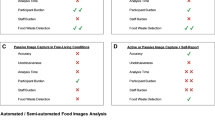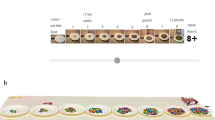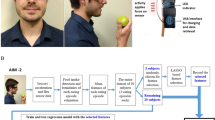Abstract
Background/Objectives:
Assessing the dietary intake of young children is challenging. In any 1 day, children may have several carers responsible for providing them with their dietary requirements, and once children reach school age, traditional methods such as weighing all items consumed become impractical. As an alternative to weighed records, food portion size assessment tools are available to assist subjects in estimating the amounts of foods consumed. Existing food photographs designed for use with adults and based on adult portion sizes have been found to be inappropriate for use with children. This article presents a review and summary of a body of work carried out to improve the estimation of portion sizes consumed by children.
Methods:
Feasibility work was undertaken to determine the accuracy and precision of three portion size assessment tools; food photographs, food models and a computer-based Interactive Portion Size Assessment System (IPSAS). These tools were based on portion sizes served to children during the National Diet and Nutrition Survey. As children often do not consume all of the food served to them, smaller portions were included in each tool for estimation of leftovers. The tools covered 22 foods, which children commonly consume. Children were served known amounts of each food and leftovers were recorded. They were then asked to estimate both the amount of food that they were served and the amount of any food leftover.
Results:
Children were found to estimate food portion size with an accuracy approaching that of adults using both the food photographs and IPSAS.
Conclusions:
Further development is underway to increase the number of food photographs and to develop IPSAS to cover a much wider range of foods and to validate the use of these tools in a ‘real life’ setting.
This is a preview of subscription content, access via your institution
Access options
Subscribe to this journal
Receive 12 print issues and online access
$259.00 per year
only $21.58 per issue
Buy this article
- Purchase on Springer Link
- Instant access to full article PDF
Prices may be subject to local taxes which are calculated during checkout



Similar content being viewed by others
References
Anderson AS, Porteous LEG, Foster E, Higgins C, Stead M, Hetherington M et al. (2005). The impact of a school-based nutrition education intervention on dietary intake and cognitive and attitudinal variables relating to fruits and vegetables. Public Health Nutr 8, 650–656.
Cameron ME, Van Staveren WA (1988). Manual on Methodology for Food Consumption Studies. Oxford University Press: Oxford.
Crawley H (1988). Food Portion Sizes, 2nd edn. HMSO: London.
Curtis PJ, Adamson AJ, Mathers JC (2001). Associations between fruit and vegetable, starch and fat consumption? Proc Nutr Soc 60, 183A.
Foster E (2003). Assessing dietary intake in primary school children. PhD thesis, University of Newcastle upon Tyne: Newcastle upon Tyne, UK.
Foster E, Matthews JNS, Nelson M, Harris J, Adamson AJ (2006). Accuracy of estimates of food portion size using food photographs—the importance of providing age-appropriate tools. Public Health Nutr 9, 509–514.
Foster E, Matthews JNS, Lloyd J, Marshall L, Mathers JCM, Nelson M et al. (2008). The development and evaluation of three portion size assessment tools for use with children. Br J Nutr 99, 175–184.
Frobisher C, Maxwell SM (2003). The estimation of food portion sizes: a comparison between using descriptions of portion sizes and a photographic food atlas by children and adults. J Hum Nutr Diet 16, 181–188.
Gregory J, Collins DL, Davies PSW, Hughes JM, Clarke CP (1995). National Diet and Nutrition Survey: Children Aged 1½–4¼ Years. HMSO: London.
Gregory J, Lowe S (2000). National Diet and Nutrition Survey: Young People Aged 4–18 Years. HMSO: London.
Hackett AF, Rugg-Gunn AJ, Appleton DR, Allinson M, Eastoe JE (1984). Sugars-eating habits of 405 11- to 14-year-old English children. Br J Nutr 51, 347–356.
Livingstone MBE, Prentice AM, Coward WA, Strain JJ, Black AE, Davies PSW et al. (1992). Validation of estimates of energy intake by weighed dietary record and diet history in children and adolescents. Am J Clin Nutr 56, 29–35.
Livingstone MBE, Robson PJ (2000). Measurement of dietary intake in children. Proc Nutr Soc 59, 279–293.
Nelson M, Atkinson M, Darbyshire S (1994). Food photographs improve estimates of nutrient intake in dietary surveys. Proc Nutr Soc 56, 205A.
Nelson M, Atkinson M, Meyer J (1997). A Photographic Atlas of Food Portion Sizes. MAFF publications: London.
Revill SA, Adamson AJ, Stacy R, Hooper J, Moynihan P (2001). The effect of an after school ‘food club’ on intake of foods and nutrients by children from deprived social backgrounds. Proc Nutr Soc 60, 189A.
Wrieden WL, Longbottom PJ, Adamson AJ, Ogston SA, Payne A, Haleem MA et al. (2008). Estimation of typical food portion sizes for children of different ages in Great Britain. Br J Nutr 99, 1344–1353.
Acknowledgements
The work to develop the age-appropriate portion size assessment tools for use in children was funded by the Food Standards Agency (project number N08019). The work on adult estimates of portion size was funded by the Ministry of Agriculture, Fisheries and Food, many thanks to Dr Michael Nelson for allowing us to use this data. Further development of the IPSAS and Food Photographs was funded by the Food Standards Agency (project number N08027). Drs Foster and Adamson are funded by NIHR (National Institute for Health Research) Personal Awards. The views expressed in this publication are those of the authors and not necessarily those of the NHS, NIHR or Department of Health.
Author information
Authors and Affiliations
Corresponding author
Additional information
Disclosure
AS Anderson has received grant support from Glaxo Smith Kline. The remaining authors have declared no financial interests.
Rights and permissions
About this article
Cite this article
Foster, E., Adamson, A., Anderson, A. et al. Estimation of portion size in children's dietary assessment: lessons learnt. Eur J Clin Nutr 63 (Suppl 1), S45–S49 (2009). https://doi.org/10.1038/ejcn.2008.64
Published:
Issue Date:
DOI: https://doi.org/10.1038/ejcn.2008.64
Keywords
This article is cited by
-
Does additional support provided through e-mail or SMS in a Web-based Social Marketing program improve children’s food consumption? A Randomized Controlled Trial
Nutrition Journal (2018)
-
A comparison of food portion size estimation by older adults, young adults and nutritionists
The Journal of nutrition, health and aging (2018)
-
Validity of self-reported lunch recalls in Swedish school children aged 6–8 years
Nutrition Journal (2013)
-
Feasibility of 2 × 24-h dietary recalls combined with a food-recording booklet, using EPIC-Soft, among schoolchildren
European Journal of Clinical Nutrition (2011)
-
Dietary assessment at the end of life's spectrum
European Journal of Clinical Nutrition (2009)



